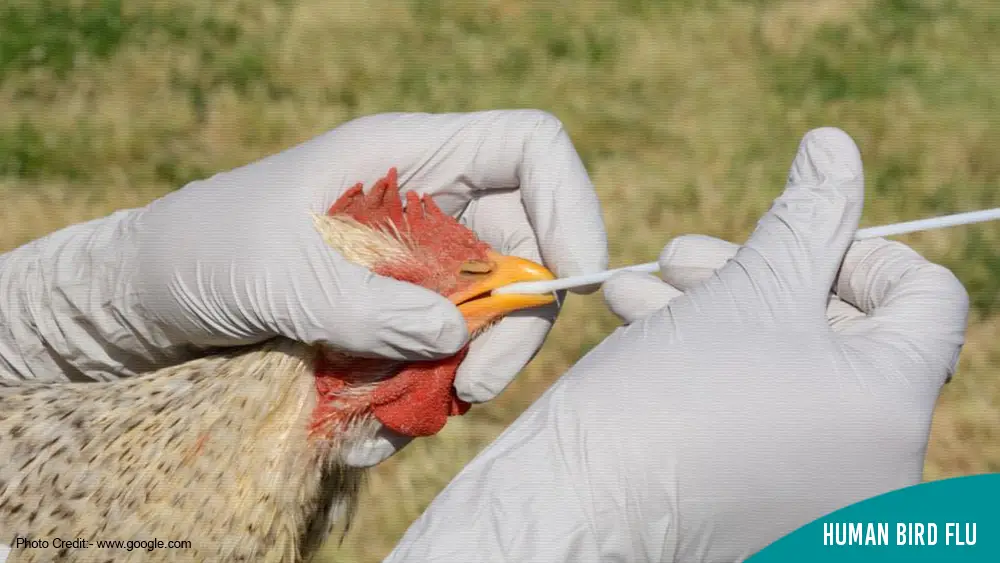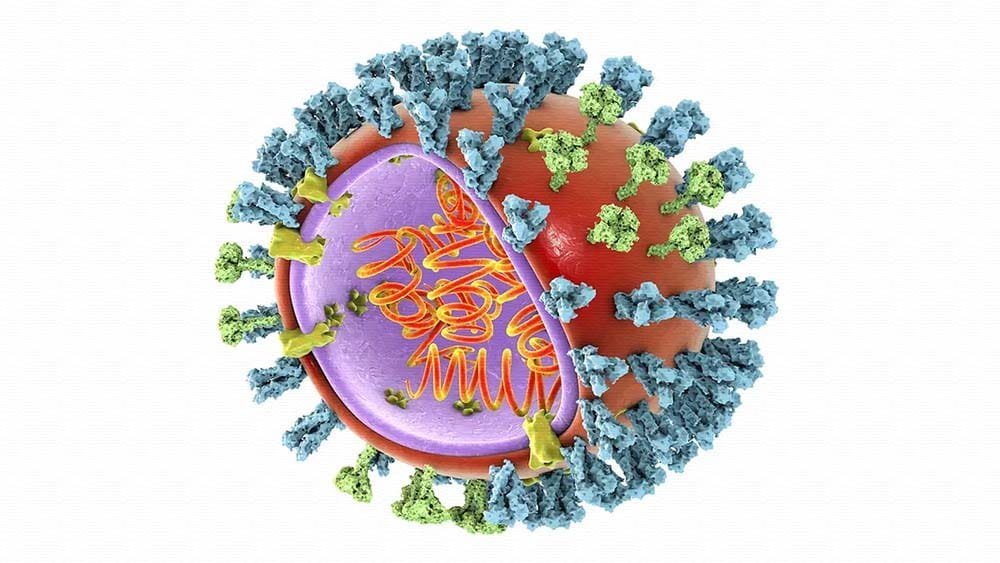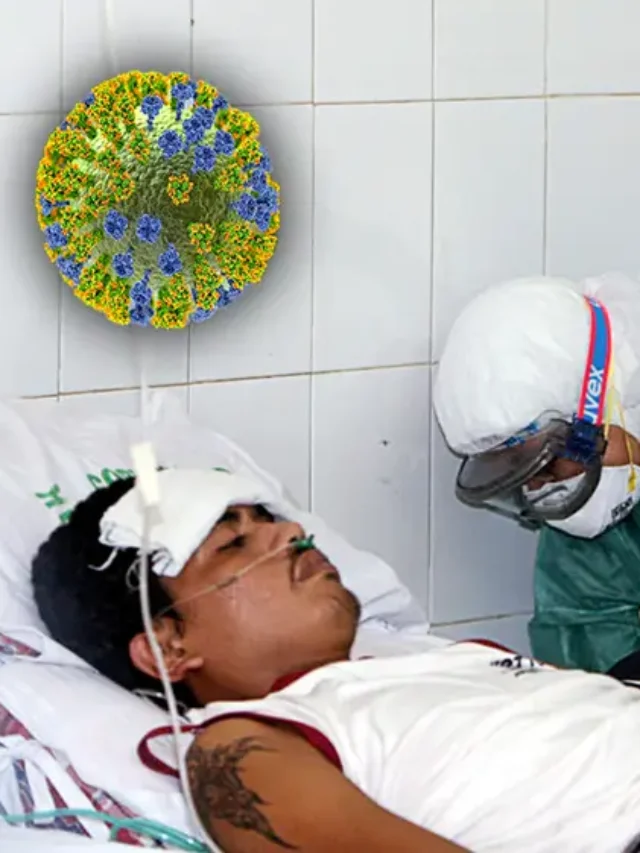
HEALTH BLOG
Human Bird Flu: Understanding the Threat and Taking Precautions
-
 Rahul Priydarss
Rahul Priydarss - April 4, 2024
Explore the economic and public health implications of avian influenza on the global poultry industry. Learn about the challenges faced, including trade disruptions and heightened biosecurity measures, and discover effective prevention and control strategies. From vaccination programs to stringent biosecurity protocols, find out how collaboration between governments, public health agencies, and the poultry industry is crucial for mitigating the impact of avian influenza outbreaks and safeguarding both animal and human populations.
What is Human Bird Flu:
Human bird flu, also known as Human bird flu, is a respiratory illness caused by strains of influenza viruses that primarily affect birds. While most avian influenza viruses do not infect humans, certain strains, such as H5N1 and H7N9, have caused sporadic cases and outbreaks of severe illness in humans.
Avian influenza viruses typically circulate among wild birds, particularly aquatic birds like ducks and geese. However, these viruses can also infect domestic poultry such as chickens and turkeys. Human infections with avian influenza usually occur through direct contact with infected birds, their droppings, or contaminated environments. In some cases, transmission can occur through the consumption of undercooked poultry products or inhalation of aerosolized virus particles.

Table of Contents
What is Avian Influenza?:
Avian influenza, commonly known as bird flu, is an infectious viral disease that primarily affects birds. It is caused by influenza A viruses, which belong to the Orthomyxoviridae family. While avian influenza viruses typically circulate among wild birds, they can also infect domestic poultry such as chickens, ducks, and turkeys. In some cases, these viruses can infect mammals, including humans and other animals.
Avian influenza viruses are classified based on the specific combination of two proteins found on their surface: hemagglutinin (H) and neuraminidase (N). There are multiple subtypes of avian influenza viruses, each identified by a unique combination of H and N proteins. These subtypes can vary in their pathogenicity and ability to cause disease in birds and other animals, including humans.
Types of Avian Influenza Viruses:
Low Pathogenic Avian Influenza (LPAI) Viruses: These viruses typically cause mild to no symptoms in infected birds. LPAI viruses are commonly found in wild bird populations and may occasionally infect domestic poultry. They usually cause minor economic losses in the poultry industry.
Highly Pathogenic Avian Influenza (HPAI) Viruses: HPAI viruses are more severe and can cause high mortality rates among infected birds. These viruses are associated with significant economic losses in the poultry industry due to widespread outbreaks and control measures. Certain HPAI strains, such as H5N1 and H7N9, have also been known to infect humans and cause severe illness.
Zoonotic Avian Influenza Viruses: Some avian influenza viruses have the ability to cross the species barrier and infect humans. While human infections with avian influenza viruses are rare, they can lead to severe respiratory illness and even death in some cases. Examples of zoonotic avian influenza viruses include H5N1, H7N9, and H9N2.
Pandemic Avian Influenza Viruses: Pandemic avian influenza viruses are strains that have the potential to cause global outbreaks of severe illness in humans. These viruses typically arise from genetic reassortment between avian influenza viruses and human influenza viruses, resulting in a novel strain to which humans have little or no immunity. The most notable example of a pandemic avian influenza virus is the H1N1 influenza virus responsible for the 1918 Spanish flu pandemic and the 2009 H1N1 pandemic.
Avian Influenza Virus Subtypes:
- H1: This subtype is commonly found in wild birds and can cause mild illness in poultry.
- H3: This subtype is another common subtype found in wild birds and can cause mild respiratory disease in poultry.
- H5: This subtype can be highly pathogenic (HPAI) or low pathogenic (LPAI) in birds. HPAI H5 viruses are of particular concern because they can cause severe illness and death in poultry and can also infect humans.
- H7: Similar to H5, this subtype can also be HPAI or LPAI. HPAI H7 viruses, such as H7N9, can cause severe disease in poultry and humans.
- H9: This subtype is primarily a low pathogenic avian influenza virus, but it has been known to cause mild illness in humans.
- Other subtypes: There are other less common subtypes of avian influenza virus, such as H6, H8, H10, H11, H12, H13, H14, H15, and H16. These subtypes can infect birds, but they rarely cause illness in humans.
Transmission of Avian Influenza to Humans:
Avian influenza, also known as bird flu, is primarily transmitted from birds to humans, not between people. Here’s how it can happen.
How does avian influenza spread to humans?:
Avian influenza, or bird flu, primarily spreads to humans through close contact with infected birds or their contaminated environments. The transmission of avian influenza viruses to humans occurs through various routes.
Direct Contact: Direct contact with infected birds, such as poultry or wild birds, is a primary mode of transmission. This can include handling sick or dead birds, touching contaminated surfaces, or being exposed to bird droppings.
Consumption of Contaminated Products: Eating undercooked or raw poultry products contaminated with the avian influenza virus can also lead to human infection. Proper cooking of poultry products at high temperatures can effectively kill the virus and reduce the risk of transmission.
Inhalation of Aerosolized Virus Particles: In some cases, avian influenza viruses can become airborne in aerosolized form. Inhalation of virus particles in environments where infected birds are present, such as live bird markets or poultry farms, can result in human infection.
Occupational Exposure: People working in the poultry industry, including farmers, poultry handlers, and workers in live bird markets, are at higher risk of exposure to avian influenza viruses due to their close contact with infected birds and their environments.
Travel to Endemic Areas: Traveling to regions where avian influenza is prevalent increases the risk of exposure to the virus. Close contact with infected poultry or contaminated environments in these areas can lead to human infection.
Risk Factors of Human Bird Flu Associated With Transmission:
Several factors can increase the risk of transmission of avian influenza viruses from birds to humans.
Close Contact with Infected Birds: Individuals who have direct contact with infected birds or their environments, such as poultry farmers, bird handlers, or workers in live bird markets, are at higher risk of transmission.
Exposure to Sick Birds: Handling or caring for sick or dead birds without proper protective measures increases the risk of infection.
Consumption of Contaminated Products: Eating undercooked or raw poultry products contaminated with the virus poses a risk of transmission.
Poor Hygiene Practices: Lack of proper hand hygiene after handling birds or their products can facilitate the spread of the virus.
Immune Status: Individuals with weakened immune systems, such as the elderly, young children, pregnant women, and those with underlying health conditions, may be more susceptible to severe illness if infected with avian influenza viruses.
Symptoms of Human Bird Flu:
Human bird flu, or avian influenza, can manifest with a range of symptoms, which may vary in severity. Common symptoms of human bird flu may include.
Fever: Fever is often one of the earliest symptoms of avian influenza infection. It may be accompanied by chills and sweating.
Cough: A persistent cough is a common symptom of avian influenza. The cough may be dry or produce phlegm.
Sore Throat: Some individuals with avian influenza may experience a sore throat, which can range from mild discomfort to severe pain.
Muscle Aches and Fatigue: Muscle aches, body aches, and general fatigue are typical symptoms of avian influenza infection. These symptoms can significantly impact daily activities and overall well-being.
Respiratory Symptoms: In severe cases, avian influenza can lead to respiratory symptoms such as difficulty breathing, shortness of breath, and chest pain. These symptoms may indicate pneumonia or acute respiratory distress syndrome (ARDS).
Headache: Headaches are a common symptom of avian influenza and may be accompanied by other flu-like symptoms such as body aches and fatigue.
Nausea, Vomiting, and Diarrhea: Some individuals with avian influenza may experience gastrointestinal symptoms such as nausea, vomiting, and diarrhea, although these are less common than respiratory symptoms.
Diagnostic Methods of Human Bird Flu:
Diagnosing human bird flu typically involves a combination of clinical evaluation, laboratory testing, and epidemiological information. Common diagnostic methods for avian influenza include.
Clinical Evaluation: Healthcare providers assess symptoms, medical history, and potential exposure to infected birds or environments. Clinical evaluation helps guide further diagnostic testing and treatment decisions.
Laboratory Testing: Laboratory tests are essential for confirming avian influenza infection. These tests may include.
- Viral Culture: Isolating the avian influenza virus from respiratory samples collected from the patient.
- Polymerase Chain Reaction (PCR): Detecting the genetic material of the avian influenza virus in respiratory specimens.
- Serological Tests: Detecting antibodies produced by the immune system in response to avian influenza virus infection.
Radiological Imaging: Chest X-rays or computed tomography (CT) scans may be performed to assess lung involvement and detect complications such as pneumonia or ARDS.
Epidemiological Investigation: Gathering information about recent travel history, contact with infected birds or individuals, and outbreaks in the community helps identify potential sources of infection and guide control measures.

Prevention and Control Measures for Avian Influenza:
Avian influenza prevention and control measures can be targeted towards two main groups: poultry and humans.
Vaccination of Avian Influenza Virus:
- Poultry Vaccination: Vaccination of domestic poultry, such as chickens, ducks, and turkeys, is an essential preventive measure against avian influenza. Vaccines are developed specifically to target prevalent strains of avian influenza viruses in poultry populations.
- Human Vaccination: While there is no widely available human vaccine for avian influenza, research is ongoing to develop vaccines that could provide protection against specific strains of the virus that pose a threat to human health.
Hygiene Practices of Avian Influenza Virus:
- Proper Hand Hygiene: Practicing regular handwashing with soap and water is crucial, especially after handling poultry, eggs, or any poultry-related equipment. Hand sanitizer can also be used when soap and water are not available.
- Safe Handling of Poultry Products: Ensure thorough cooking of poultry products, including eggs, to kill any potential avian influenza viruses. Avoid consuming undercooked or raw poultry products.
- Protective Clothing and Equipment: Individuals working with poultry should wear appropriate protective clothing, such as gloves and masks, to minimize the risk of exposure to the virus.
- Disinfection of Equipment and Surfaces: Regular cleaning and disinfection of equipment, surfaces, and facilities in poultry farms or live bird markets help prevent the spread of avian influenza viruses.
Controlling Poultry Outbreaks of Avian Influenza Virus:
- Surveillance and Early Detection: Implementing robust surveillance systems to monitor poultry populations for signs of avian influenza outbreaks is essential. Early detection allows for prompt intervention and control measures.
- Culling of Infected Birds: In the event of an avian influenza outbreak, infected poultry must be culled to prevent further spread of the virus. This measure helps contain the outbreak and reduce the risk of transmission to other birds or humans.
- Quarantine and Movement Restrictions: Implementing quarantine measures and movement restrictions for poultry in affected areas help prevent the spread of avian influenza to other regions. Restricting the movement of birds, poultry products, and equipment can help contain the outbreak.
- Biosecurity Measures: Enhancing biosecurity measures in poultry farms, including controlling access to facilities, implementing hygiene protocols, and preventing contact with wild birds, helps reduce the risk of introduction and spread of avian influenza viruses.
- Training: Providing training to poultry farmers, workers, and stakeholders about the importance of biosecurity measures, early detection, and reporting of avian influenza outbreaks enhances preparedness and response efforts.
Treatment Options for Human Bird Flu:
The primary treatment for avian influenza in humans is antiviral medication. Here’s a breakdown of the treatment options.
Antiviral Medications:
- Neuraminidase Inhibitors: Antiviral medications such as oseltamivir (Tamiflu) and zanamivir (Relenza) are commonly used to treat avian influenza infections in humans. These medications work by inhibiting the activity of the neuraminidase enzyme, which is essential for the replication of influenza viruses.
- Baloxavir Marboxil: Another antiviral medication, baloxavir marboxil (Xofluza), has shown effectiveness against influenza viruses, including some strains of avian influenza. It works by inhibiting the cap-dependent endonuclease enzyme, disrupting viral replication.
- Adamantanes: Some avian influenza strains may be susceptible to adamantane antiviral medications such as amantadine and rimantadine. However, widespread resistance to these drugs has been observed in recent years, limiting their effectiveness.
Important Points About Antiviral Treatment:
- Early initiation is key: Antiviral medications are most effective when taken within 48 hours of symptom onset. Early diagnosis is crucial for timely treatment initiation.
- Effectiveness can vary: The effectiveness of antivirals against different avian influenza strains can vary. Some strains may show resistance to certain drugs.
- Prescription required: Antiviral medications are prescription drugs and should only be taken under the guidance of a healthcare professional.
- Doesn’t cure but helps manage: Antiviral medications don’t cure avian influenza but can help reduce the severity and duration of symptoms and potentially prevent complications.
Supportive Care:
In addition to antiviral medications, supportive care is also essential for patients with avian influenza. This may include.
- Fluids and Rest: Adequate hydration and rest are essential for individuals infected with avian influenza. Drinking plenty of fluids helps prevent dehydration, while rest allows the body to fight off the infection.
- Fever Reducers: Over-the-counter medications such as acetaminophen (Tylenol) or ibuprofen (Advil, Motrin) can help reduce fever and relieve symptoms of pain and discomfort associated with avian influenza infection.
- Respiratory Support: In severe cases of avian influenza with respiratory complications, supportive measures such as supplemental oxygen therapy or mechanical ventilation may be necessary to assist breathing and maintain adequate oxygen levels in the blood.
- Treatment of Complications: Prompt treatment of complications such as pneumonia or bacterial co-infections is essential for improving outcomes in individuals with severe avian influenza infections. Antibiotics may be prescribed if bacterial infections are present.
Global Impact of Human Bird Flu:
A human bird flu pandemic has the potential for severe economic and public health consequences on a global scale. Here’s a breakdown of the potential impacts.
Economic Implications:
Impact on Poultry industry: Outbreaks of highly pathogenic avian influenza (HPAI) in poultry can cause devastating economic losses. The mass culling of infected flocks and restrictions on poultry movement can significantly disrupt the poultry industry. This can lead to:
- Shortages of poultry products: Reduced supply due to culling and movement restrictions can drive up prices and lead to shortages of chicken, eggs, and other poultry products.
- Loss of jobs: Poultry farm closures and disruptions in the poultry supply chain can lead to job losses across the industry.
- International trade impact: Countries may impose import/export restrictions on poultry products from affected regions, further impacting trade.
Impact on Travel and tourism: A widespread human bird flu pandemic could lead to travel restrictions and a decline in tourism as people avoid traveling to affected areas.
Impact on Other sectors: Disruptions in the poultry industry and overall economic slowdown can have cascading effects on other sectors like food service and retail.
Impact on Public Health:
- Increased illness and death: A pandemic can lead to a significant number of people becoming sick and potentially dying from bird flu. The severity of illness can vary depending on the specific strain of the virus, but some strains have shown high mortality rates in humans.
- Strain on healthcare systems: A surge in patients with bird flu can overwhelm healthcare systems, leading to shortages of medical supplies and personnel.
- Social disruption: Fear and panic associated with a pandemic can lead to social disruption, including school closures, quarantines, and disruptions to daily life.
Recent Outbreaks and Cases:
Here’s a summary of recent notable avian influenza outbreaks and human cases worldwide.
Outbreaks in Poultry: The H5N1 strain of avian influenza has been causing widespread outbreaks in poultry flocks globally since late 2021. Countries in Europe, Asia, Africa, and North America have all reported cases. The U.S. Centers for Disease Control and Prevention (CDC) reports ongoing outbreaks in wild birds and sporadic outbreaks in poultry flocks within the United States.
Human Cases:
- As of April 4, 2024, the World Health Organization (WHO) reports a total of 888 human cases of H5N1 infection globally since 2003, with 463 deaths.
- In February 2024, Cambodia reported the first human H5N1 cases of the year.
- In March 2024, a human case of H5N1 infection was reported in Vietnam, resulting in the death of the patient.
- On April 1, 2024, the CDC reported the first human case of H5N1 infection in the United States in 2024.
Some additional resources for information:
- World Organisation for Animal Health (WOAH): https://www.woah.org/en/disease/avian-influenza/
- World Health Organization (WHO): https://www.who.int/teams/health-product-policy-and-standards/standards-and-specifications/vaccines-quality/influenza
- Centers for Disease Control and Prevention (CDC): https://www.cdc.gov/flu/avianflu/index.htm
Government Responses and Policies to Avian Influenza or Human Bird Flu:
The threat of avian influenza pandemics necessitates a two-pronged approach: international cooperation and strong national strategies. Here’s a breakdown of these aspects.
International Cooperation:
World Organisation for Animal Health (WOAH): This intergovernmental organization plays a crucial role in coordinating global efforts against animal diseases like avian influenza. They.
- Standardize disease reporting: Establish protocols for countries to report outbreaks promptly and share information about the specific viral strains involved.
- Develop guidelines: Create guidelines for surveillance, control measures, and international trade of poultry products during outbreaks.
- Facilitate communication and collaboration: Promote communication and collaboration between countries to share best practices and coordinate responses.
World Health Organization (WHO): The WHO works alongside WOAH to address the human health aspects of avian influenza. They.
- Monitor human cases: Track and report on human cases of avian influenza globally.
- Develop pandemic preparedness plans: Collaborate with member states to develop national and international pandemic preparedness plans.
- Research and development: Support research and development of vaccines and antiviral medications for avian influenza.
National Strategies:
Surveillance: Strong surveillance programs are crucial for early detection of outbreaks in poultry flocks and wild birds. This allows for swift implementation of control measures.
Biosecurity measures: Governments can promote and enforce biosecurity measures in poultry farms to minimize the risk of introduction and spread of the virus.
Emergency response plans: Developing and regularly updating national emergency response plans are essential for a coordinated and effective response to outbreaks.
- – Culling infected flocks
- – Disinfection of premises
- – Movement restrictions for poultry and poultry products
- – Public communication campaigns
Stockpiling of antivirals: Maintaining a stockpile of antiviral medications can ensure availability for treatment during outbreaks.
Public awareness campaigns: Educating the public about the risks of avian influenza, preventive measures, and what to do in case of an outbreak is crucial.
Examples of National Strategies:
The United States Department of Agriculture (USDA) has an Avian Influenza Preparedness and Response Plan that outlines their strategies for preventing, detecting, and controlling avian influenza in poultry [https://www.woah.org/en/disease/avian-influenza/].
The European Commission has a strategy for tackling avian influenza that outlines measures for surveillance, prevention, control, and preparedness [https://ec.europa.eu/food/animals/animal-diseases/control-measures/avian-influenza_en].
Future Prospects and Research in Avian Influenza:
Avian influenza research is constantly evolving to address the ongoing threat posed by this virus. Here’s a glimpse into some emerging trends and potential innovations.
Emerging Research Trends:
Understanding viral evolution: Researchers are focusing on understanding how avian influenza viruses evolve and mutate to better predict the emergence of new strains with pandemic potential.
Wild bird reservoirs: Studying the role of wild birds as natural reservoirs of avian influenza viruses is crucial for understanding transmission dynamics and developing targeted interventions.
Human-adapted influenza strains: Research on the emergence of influenza strains with increased ability to transmit between humans is crucial for pandemic preparedness.
Improved diagnostics: Developing rapid, accurate, and user-friendly diagnostic tests for avian influenza will be essential for early detection and control of outbreaks.
Innovations in Prevention and Treatment:
Universal influenza vaccines: Research is ongoing to develop universal influenza vaccines that would provide protection against a broad range of influenza A viruses, including potential pandemic strains.
Next-generation antivirals: Developing new antiviral medications with broader activity against different influenza strains, including those resistant to current drugs.
Immunomodulatory therapies: Exploring therapies that modulate the immune system’s response to avian influenza infection, potentially improving outcomes.
Surveillance advancements: Utilizing advanced technologies like genetic sequencing for more comprehensive surveillance of avian influenza viruses in birds and humans.
Impact of Avian Influenza on the Poultry Industry:
Avian influenza outbreaks can have a devastating impact on the poultry industry, causing significant economic repercussions and necessitating stricter biosecurity measures.
Economic Repercussions:
Culling of infected flocks: To prevent the spread of the virus, authorities often mandate the culling of entire infected flocks. This leads to a significant loss of poultry products like meat and eggs.
Reduced egg production: Even subclinical infections with low pathogenic avian influenza (LPAI) strains can cause a decrease in egg production, impacting egg supplies and prices.
Movement restrictions: To control the spread of the virus, movement restrictions may be imposed on poultry and poultry products. This disrupts supply chains and can lead to shortages and price hikes for consumers.
Loss of export markets: Countries may ban poultry imports from regions experiencing outbreaks, leading to lost export revenue for producers.
Increased production costs: Implementing stricter biosecurity measures can increase production costs for poultry farmers.
Biosecurity Measures:
To minimize the risk of avian influenza outbreaks and mitigate economic losses, poultry farms need to implement robust biosecurity measures. These can include.
Restricted access: Limit visitors and control the movement of people, vehicles, and equipment in and out of the farm. This helps prevent the introduction of the virus from external sources.
Quarantine procedures: Isolate new birds for a period before introducing them to the main flock to monitor for any signs of illness.
Proper rodent and pest control: Prevent wild birds and rodents from coming in contact with poultry. These animals can carry the virus and spread it between farms.
Disinfection: Regularly disinfect poultry houses, equipment, and vehicles with appropriate disinfectants to eliminate any potential viral contamination.
Vaccination: In some regions with high LPAI risk, vaccination of poultry flocks might be considered. However, vaccination is not a substitute for good biosecurity practices.
Surveillance: Regularly monitor poultry flocks for signs of illness and report any suspicious cases to veterinary authorities. Early detection is crucial for containing outbreaks and minimizing economic losses.
FAQs about Human Bird Flu:
A1: No, properly cooked poultry products pose no risk of avian influenza transmission to humans.
A2: Travel advisories may be issued for regions experiencing avian influenza outbreaks, but restrictions vary depending on the severity of the situation.
A3: While vaccines for certain avian influenza strains are under development, no vaccine provides universal protection against all subtypes.
A4: Poultry farmers should practice strict biosecurity measures, including restricting access to farms, disinfecting equipment, and monitoring bird health.
A5: Yes, avian influenza viruses have the potential to mutate and acquire traits that enhance their transmissibility to humans, posing a risk of pandemic spread.

-Please remember, to always consult with healthcare professionals or Doctors for personalised advice related to medical conditions.
Conclusion:
In conclusion, Human Bird Flu or avian influenza poses significant economic and public health challenges globally. Its impact on the poultry industry includes economic losses, trade disruptions, and heightened biosecurity measures. Effective prevention and control strategies, such as vaccination programs and stringent biosecurity protocols, are crucial for mitigating the spread of the virus and safeguarding poultry health.




